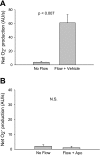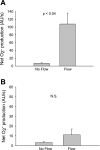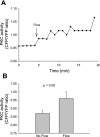PKC-alpha mediates flow-stimulated superoxide production in thick ascending limbs
- PMID: 20053794
- PMCID: PMC2853312
- DOI: 10.1152/ajprenal.00543.2009
PKC-alpha mediates flow-stimulated superoxide production in thick ascending limbs
Abstract
We showed that luminal flow increases net superoxide (O(2)(-)) production via NADPH oxidase in thick ascending limbs. Protein kinase C (PKC) activates NADPH oxidase activity in phagocytes, cardiomyocytes, aortic endothelial cells, vascular smooth muscle cells, and renal mesangial cells. However, the flow-activated pathway that induces NADPH oxidase activity in thick ascending limbs is unclear. We hypothesized that PKC mediates flow-stimulated net O(2)(-) production by thick ascending limbs. Initiation of flow (20 nl/min) increased net O(2)(-) production from 4 +/- 1 to 61 +/- 12 AU/s (P < 0.007; n = 5). The NADPH oxidase inhibitor apocynin completely blocked the flow-induced increase in net O(2)(-) production (2 +/- 1 vs. 1 +/- 1 AU/s; P > 0.05; n = 5). Flow-stimulated O(2)(-) was also blocked in p47(phox)-deficient mice. We measured flow-stimulated PKC activity with a fluorescence resonance energy transfer (FRET)-based membrane-targeted PKC activity reporter and found that the FRET ratio increased from 0.87 +/- 0.02 to 0.96 +/- 0.04 AU (P < 0.05; n = 6). In the absence of flow, the PKC activator phorbol 12-myristate 13-acetate (200 nM) enhanced net O(2)(-) production from 5 +/- 2 to 92 +/- 6 AU/s (P < 0.001; n = 6). The PKC-alpha- and betaI-selective inhibitor Gö 6976 (100 nM) decreased flow-stimulated net O(2)(-) production from 54 +/- 15 to 2 +/- 1 AU/s (P < 0.04; n = 5). Flow-induced net O(2)(-) production was inhibited in thick ascending limbs transduced with dominant-negative (dn)PKC-alpha but not dnPKCbetaI or LacZ (Delta = 11 +/- 3 AU/s for dnPKCalpha, 55 +/- 7 AU/s for dnPKCbetaI, and 63 +/- 7 AU/s for LacZ; P < 0.001; n = 6). We concluded that flow stimulates net O(2)(-) production in thick ascending limbs via PKC-alpha-mediated activation of NADPH oxidase.
Figures







Comment in
-
NO solution for a radical problem: a TAL story.Am J Physiol Renal Physiol. 2010 Apr;298(4):F883-4. doi: 10.1152/ajprenal.00023.2010. Epub 2010 Feb 3. Am J Physiol Renal Physiol. 2010. PMID: 20130124 No abstract available.
Similar articles
-
Endogenous flow-induced superoxide stimulates Na/H exchange activity via PKC in thick ascending limbs.Am J Physiol Renal Physiol. 2014 Oct 1;307(7):F800-5. doi: 10.1152/ajprenal.00260.2014. Epub 2014 Jul 30. Am J Physiol Renal Physiol. 2014. PMID: 25080525 Free PMC article.
-
Angiotensin II stimulates thick ascending limb superoxide production via protein kinase C(α)-dependent NADPH oxidase activation.J Biol Chem. 2010 Jul 9;285(28):21323-8. doi: 10.1074/jbc.M110.109157. Epub 2010 May 6. J Biol Chem. 2010. PMID: 20448043 Free PMC article.
-
Angiotensin II stimulates superoxide production by nitric oxide synthase in thick ascending limbs.Physiol Rep. 2016 Feb;4(4):e12697. doi: 10.14814/phy2.12697. Physiol Rep. 2016. PMID: 26884476 Free PMC article.
-
Flow increases superoxide production by NADPH oxidase via activation of Na-K-2Cl cotransport and mechanical stress in thick ascending limbs.Am J Physiol Renal Physiol. 2007 Mar;292(3):F993-8. doi: 10.1152/ajprenal.00383.2006. Epub 2006 Nov 28. Am J Physiol Renal Physiol. 2007. PMID: 17132867
-
Luminal flow regulates NO and O2(-) along the nephron.Am J Physiol Renal Physiol. 2011 May;300(5):F1047-53. doi: 10.1152/ajprenal.00724.2010. Epub 2011 Feb 23. Am J Physiol Renal Physiol. 2011. PMID: 21345976 Free PMC article. Review.
Cited by
-
NADPH oxidases, reactive oxygen species, and the kidney: friend and foe.J Am Soc Nephrol. 2013 Oct;24(10):1512-8. doi: 10.1681/ASN.2012111112. Epub 2013 Aug 22. J Am Soc Nephrol. 2013. PMID: 23970124 Free PMC article. Review.
-
Modulation of outer medullary NaCl transport and oxygenation by nitric oxide and superoxide.Am J Physiol Renal Physiol. 2011 Nov;301(5):F979-96. doi: 10.1152/ajprenal.00096.2011. Epub 2011 Aug 17. Am J Physiol Renal Physiol. 2011. PMID: 21849492 Free PMC article.
-
Study of possible mechanisms involved in the inhibitory effects of coumarin derivatives on neutrophil activity.Oxid Med Cell Longev. 2013;2013:136570. doi: 10.1155/2013/136570. Epub 2013 Nov 17. Oxid Med Cell Longev. 2013. PMID: 24349608 Free PMC article.
-
Increase of sodium delivery stimulates the mitochondrial respiratory chain H2O2 production in rat renal medullary thick ascending limb.Am J Physiol Renal Physiol. 2012 Jan 1;302(1):F95-F102. doi: 10.1152/ajprenal.00469.2011. Epub 2011 Oct 5. Am J Physiol Renal Physiol. 2012. PMID: 21975873 Free PMC article.
-
Endogenous flow-induced superoxide stimulates Na/H exchange activity via PKC in thick ascending limbs.Am J Physiol Renal Physiol. 2014 Oct 1;307(7):F800-5. doi: 10.1152/ajprenal.00260.2014. Epub 2014 Jul 30. Am J Physiol Renal Physiol. 2014. PMID: 25080525 Free PMC article.
References
-
- Amlal H, LeGoff C, Vernimmen C, Soleimani M, Paillard M, Bichara M. ANG II controls Na+-K+(NH4+)-2Cl− cotransport via 20-HETE and PKC in medullary thick ascending limb. Am J Physiol Cell Physiol 274: C1047–C1056, 1998 - PubMed
-
- Bey EA, Xu B, Bhattacharjee A, Oldfield CM, Zhao X, Li Q, Subbulakshmi V, Feldman GM, Wientjes FB, Cathcart MK. Protein kinase C delta is required for p47phox phosphorylation and translocation in activated human monocytes. J Immunol 173: 5730–5738, 2004 - PubMed
-
- Bullard TA, Hastings JL, Davis JM, Borg TK, Price RL. Altered PKC expression and phosphorylation in response to the nature, direction, and magnitude of mechanical stretch. Can J Physiol Pharmacol 85: 243–250, 2007 - PubMed
-
- Dang PM, Fontayne A, Hakim J, El Benna J, Perianin A. Protein kinase C zeta phosphorylates a subset of selective sites of the NADPH oxidase component p47phox and participates in formyl peptide-mediated neutrophil respiratory burst. J Immunol 166: 1206–1213, 2001 - PubMed
-
- Dempsey EC, Newton AC, Mochly-Rosen D, Fields AP, Reyland ME, Insel PA, Messing RO. Protein kinase C isozymes and the regulation of diverse cell responses. Am J Physiol Lung Cell Mol Physiol 279: L429–L438, 2000 - PubMed
Publication types
MeSH terms
Substances
Grants and funding
LinkOut - more resources
Full Text Sources
Molecular Biology Databases
Research Materials

